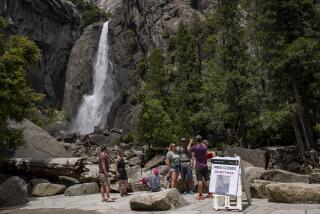Yosemite, 5 Counties Agree on Bus Plan
- Share via
Voting to create a regional transit system, officials of Yosemite National Park and the five adjacent counties have taken the first official steps toward solving the increasingly serious problem of traffic congestion in Yosemite Valley.
The officials voted Monday to establish a bus system that could transport more than 800,000 visitors a year by the end of the next decade.
“For the first time in 20 years of talking and planning, we have a series of steps toward creating a regional transportation system that elected officials from gateway communities can sign onto,” said Chip Jenkins, chief of strategic planning and partnerships for the park.
But Jenkins cautioned that the system will be a limited one, likely only to reduce traffic in the valley by a fraction in the first two years of operation.
“What was accepted yesterday was a phased-in plan for a system that will lead to a handful of buses bringing in people. Hopefully, five years from now, as we ramp this up, there will be an appreciable decrease in the amount of traffic in the valley,” he said.
Scheduled to begin as a pilot project next summer from early June through Labor Day, the bus service will never rid the valley of cars as some transit advocates have hoped.
Indeed, the buses, which will run hourly from the park’s main entrance at El Portal and four to six times a day from other locations, aren’t expected to carry more than 75,000 to 80,000 summer visitors next year.
Officials say that even with the bus system, the park probably won’t be able to shelve a controversial proposal to build an 1,800-car parking lot or garage at the west end of the valley--although the size and location of it may be altered.
“We are still going to need some level of parking,” Jenkins said.
Despite the limitations, spokesmen for environmental groups praised the transit plan.
“It’s reality. It’s what is possible,” said Jay Watson of the Wilderness Society.
Officials of some surrounding communities that depend on tourism generated by Yosemite have expressed concern that a ban on cars in the valley would discourage people from coming to the park. Others fear that a ban would simply move the congestion from Yosemite Valley to nearby towns.
About 4 million people visit the park each year. Visitorship is expected to grow to at least 6 million in the next 10 years. Summer is by far the busiest season.
Use of the buses will be voluntary, but as incentives to ride them visitors will be offered reduced park entrance fees. People arriving in their cars now pay $20.
According to Jenkins, bus riders will only have to pay $3 per person or $6 per family.
Moreover, the buses will be able to bypass the long lines of cars waiting to get in the park, and riders will be assured of admission on those occasional days when the valley can’t accommodate more cars.
“We are hoping to develop deals where hotels and motels in surrounding communities will include entrance fees in the cost of lodging packages,” said Jesse Brown, director of the Yosemite Area Regional Transit Strategy group that approved the bus system.
Brown said the current plan is for the buses to pick up passengers at hotels and motels outside the park--to the south in communities along California 41 and to the east along California 140 in El Portal and Mariposa.
Visitors entering on California 120 from Oakdale will be able to catch buses inside the park, Brown said, leaving their cars in a lot at the juncture of 120 and the Tioga Road.
According to Brown, the system is being designed to pay for itself and ultimately make a profit. The five-county transit group has received $500,000 in federal highway funds to plan and market the system.
“At this point, we only need to find some funds to pay for Park Service personnel and concessionaire employees to use the system, so they wont be driving in,” he said.
“Eventually, we may look for federal grants to purchase our own buses,” Brown said. “Now, we’re going to ask for bids from transit companies to operate the service.”
More to Read
Sign up for Essential California
The most important California stories and recommendations in your inbox every morning.
You may occasionally receive promotional content from the Los Angeles Times.













